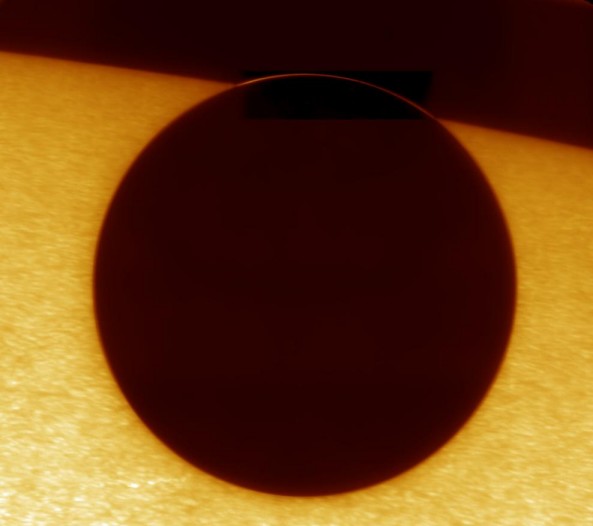"Venus in the west was as
bright as a street lamp, as bright as life, as bright as Miss Huntress' eyes, as
bright as a bottle of Scotch"*
.....For
months, now, Venus has been bright in the western sky. As I write
this, I am looking out of our living room window at Venus, shining
brightly in the west. (For the next couple of days, Venus will be near
the star El Nath, in Taurus, the tip of the southern horn of the bull
and very close to the Crab Nebula.) Venus is now getting less and less
prominent in the evening, getting closer and closer to the western
horizon as Venus races to pass us on our orbit. Most times, that would
be that for seeing Venus, until Venus appears in the morning sky in late
June. This time, as Venus passes by us, it will be visible as a shadow
across the Sun.
.....It
would seem like this should happen more often; if you ask a small child
to draw the solar system (I would do this all the time, so I assume
that all kids do this), the final result of nearly circles in a flat
page would be very close to how the solar system is - but not quite.
The flat sheet of paper is close, as the planets orbit in very close to
the same plane. the orbit of Venus, for example, is at an angle of 3.39
degrees to the plane of the Earth's orbit. Now, if I said that I would
fling a baseball not at the center of your face, but at an angle of
3.39 degrees above the center, you would probably not be very happy.**
However, at the distance of Venus at its closest, Venus makes a dot of
only 0.008 degrees across against the sky, so the chance of this dot
overlapping the half-degree dot of the Sun is very infrequent. The last
time, before 2004, was 1882. The next time will be in December of
2117.

.....In
the late afternoon of June 5th (next month!) we will get to see this.
The continental US will see Venus still transiting the Sun as it sets.
Japan would be an excellent place to view the transit from, with Wake
Island being perhaps the best of all. (Geez, this would have been a
good time to go back to Guam.) As this month progresses, I will have a
number of posts on how to watch this, but I wanted to start now.

.....Still,
while I was trying to find a public domain image of Venus to use, I
came across this image, where sunlight can be seen shining through Venus' atmosphere. Cool.
.....My next
post will be about how to view the transit safely. One could buy
special film glasses to view the eclipse, but be absolutely sure that
the film is not just "dark", but is
specifically made
to protect against ultraviolet light. My next post will talk about why
this is a danger, but just for the love of anything you like actually looking at, never stare directly at the Sun unless you abso-fraggin'-lutely know what you're doing.
**
Don't worry; this is just an example. There is a fairly limited number
of people that I would like to smash in face the face with baseball, so
I use this for a purely illustrative purposes. Still, if you're not
sure, ask.
**duh






 .....In
the late afternoon of June 5th (next month!) we will get to see this.
The continental US will see Venus still transiting the Sun as it sets.
Japan would be an excellent place to view the transit from, with Wake
Island being perhaps the best of all. (Geez, this would have been a
good time to go back to Guam.) As this month progresses, I will have a
number of posts on how to watch this, but I wanted to start now.
.....In
the late afternoon of June 5th (next month!) we will get to see this.
The continental US will see Venus still transiting the Sun as it sets.
Japan would be an excellent place to view the transit from, with Wake
Island being perhaps the best of all. (Geez, this would have been a
good time to go back to Guam.) As this month progresses, I will have a
number of posts on how to watch this, but I wanted to start now. .....Still,
while I was trying to find a public domain image of Venus to use, I
came across this image, where sunlight can be seen shining through Venus' atmosphere. Cool.
.....Still,
while I was trying to find a public domain image of Venus to use, I
came across this image, where sunlight can be seen shining through Venus' atmosphere. Cool.